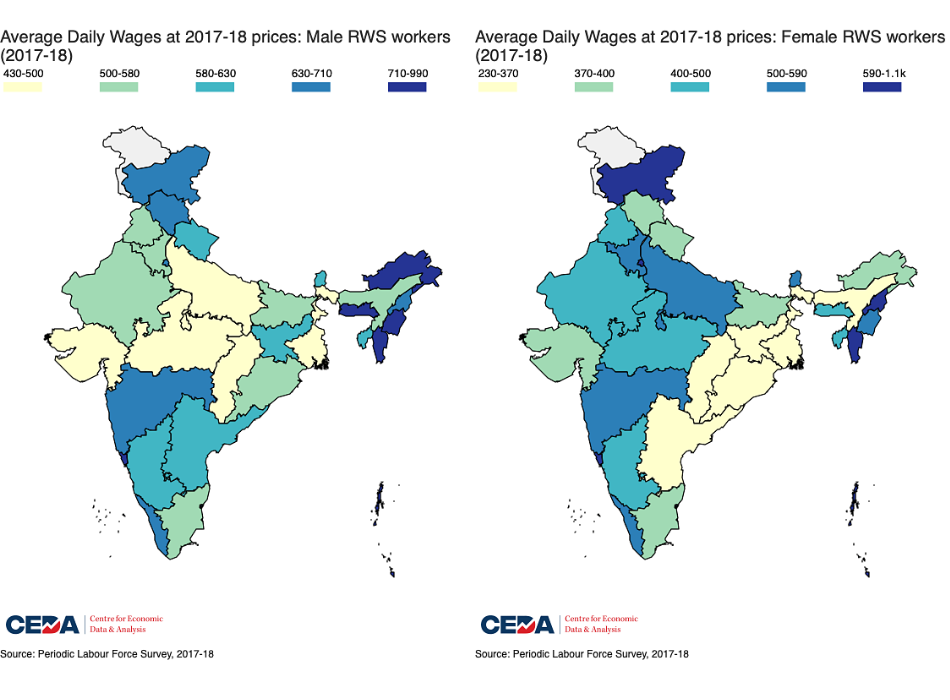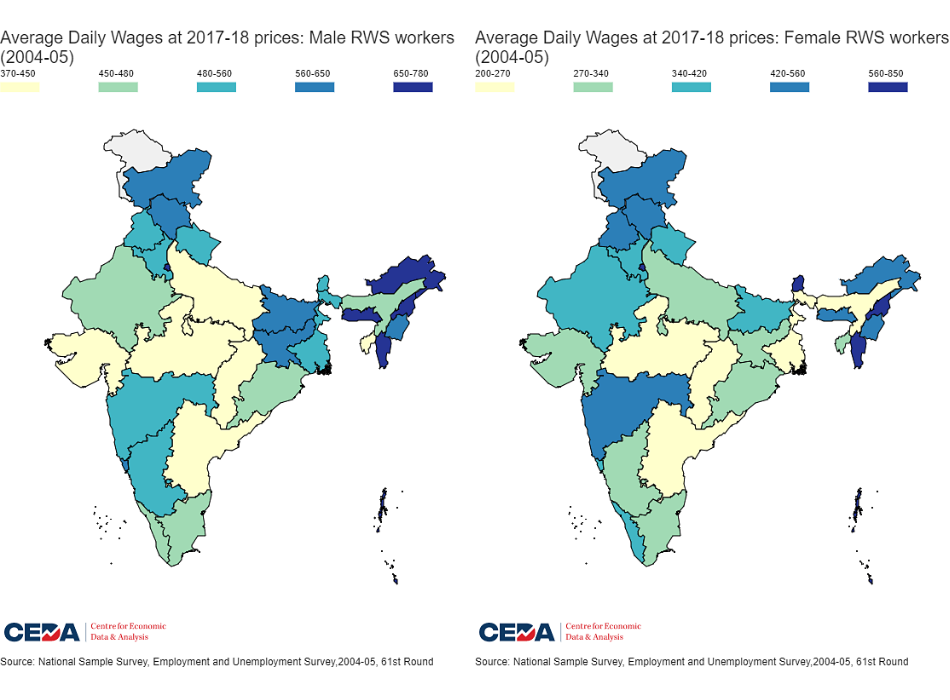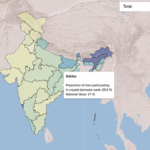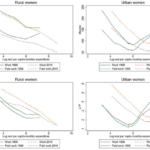GenderStats 10: How do Women’s Wages Compare with that of Men?
There has been a great deal of attention on the phenomenon of declining women’s participation in the labour force and in paid work. Previous CEDA bulletins have focused on gender gaps in job losses. In this post, we look at the average daily wages received by both male and female “regular wage and salaried workers” (RWS) across Indian states based on data from the 61st Round of the National Sample Survey (NSS) – which covers the period 2004-05 – and the Periodic Labour Force Survey (PLFS) of 2017-18.
The NSS classifies workers into three broad categories: casual workers (CL), regular wage and salaried (RWS) and self-employed (SE). The last category is further sub-divided into three categories: own account workers (working for themselves in a single employee outfit), employers, and unpaid worker in household enterprises. Wage data is typically available for RWS and CL. Here, we focus on wage data for RWS workers.
In contrast to casual workers, RWS workers are hired for fixed periods of time (could be for a few months or years) and receive regular wages and/or salaries, as opposed to daily wages or piece rate wages that casual workers would receive. We present average daily wages, which are calculated as follows. The PLFS survey asks workers about two activities that they participated in seven days preceding the survey. For each day separately, workers report “hours worked” and earnings. These can be aggregated and averaged over all workers to calculate average “daily wages”.
The estimates are adjusted for inflation by presenting average wages in constant terms at 2017-18 prices. On the CEDA data portal, you can visualize the wage data in many different ways. This is just one example out of many.
Figure 1 shows the state-level average daily wages of male and female RWS workers for 2017-18. At the national level, there is a clear gender gap, with women’s wages roughly 78 percent that of men (Rs 552.78 for men and Rs 433.7 for women). Interestingly, states with high wages for men are not those that display high wages for women. The only states that have wages in excess of Rs 500 per day for both men and women (the darkest blue in the heatmaps) are Kerala, Haryana, Jammu and Kashmir, and the north-eastern states of Nagaland, Mizoram and Manipur.
Figure 1

The largest gap in wages is seen in Arunachal Pradesh, where wages for women are only 41 percent that of men. Large gaps are also seen in some states like Assam – where women’s wages are 55 percent that of men – Jharkhand (57 percent) and Andhra Pradesh (59.12 percent). Interestingly, two northern states, Haryana and Uttar Pradesh, have women’s wages higher than that of men, though wages for men in UP are lower than the nation-wide average.
Though these two states have high wages, their low labour force participation rates for women imply that the gains of relatively high wages are shared by a very small proportion of women. As recorded in the PLFS, the labour force participation rates of women aged 15 to 59 in 2017-18 in Haryana and Uttar Pradesh are 16% and 14.2% respectively, much lower than the nation-wide average of 25.3%. (The labour force participation rate measures the percentage of individuals in the relevant age group engaged in the labour force).
Figure 2 shows average daily wages for male and female RWS workers in 2004-05 in terms of 2017-18 prices. For women, the highest wages are to be found in Punjab and in the north-east. Once again, the states which have high wages for men are not the ones which have high wages for women, as seen in the cases of Bihar, Jharkhand, Karnataka and Haryana, amongst others.
Figure 2

While a significant wage gap between male and female regular wage workers still exists in 2017-18, the gap has reduced over time. In 2004-05, women’s wages were only 70 percent that of men. In states like Jharkhand, Madhya Pradesh and Chhattisgarh, for instance, women’s wages were less than half that of men’s wages. Uttar Pradesh and Haryana, which showed higher wages for women than men in 2017-18, display the opposite trend here, with women’s wages 73 percent less than men in Haryana and 84 percent lesser in Uttar Pradesh in 2004-05.
What a comparison of these two years indicates is that though a gender gap in wages still exists, women’s wages for RWS work have increased at a faster rate than that of men. States like Haryana and Uttar Pradesh have seen women’s wages rise at far greater rates than others, leading to women’s wages overtaking that of men as of 2017-18.
But this does not necessarily indicate reason for optimism. For one, these graphs display the situation before the pandemic, and hence we cannot assume that women’s wages would continue to grow – and the gap continue to shrink – in a changed economic and social landscape. Secondly, given the huge reduction in women’s labour force participation over time, these (relatively) high wages are only being made available for a shrinking pool of women. As outlined in Deshpande and Singh (2021), women face significant obstructions not just on the supply-side, but also with regard to the demand for labour. More work is required to understand the dynamics of wage growth and gender in India over the past few decades.
References:
- Deshpande, Ashwini and Jitendra Singh (2021): “Dropping Out, Being Pushed Out or Can’t Get In? Decoding Declining Labour Force Participation of Indian Women”, IZA Discussion Paper No 14639, IZA Institute of Labor Economics
If you wish to republish this article or use an extract or chart, please read CEDA’s republishing guidelines.







